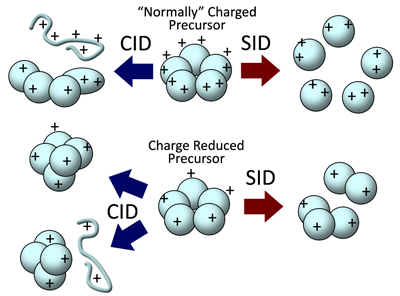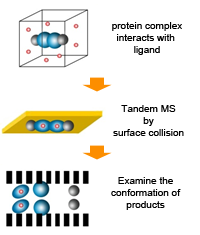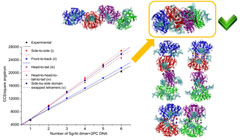The list below shows some representative projects on mass spectrometry and ion mobility studies of protein and protein-ligand systems. There are also some collaborative projects within the department and with other universities to solve specific structural questions about protein systems.
Protein-Ligand Complexes |
Investigating ligand-mediated conformational changes of protein complexes by Tandem Mass Spectrometry and Ion Mobility |
|
|
Identifying ligand binding sites on a protein and their associated conformational sites is vital in gaining insight into many applications, such as molecular docking, de novo drug design and structural identification and comparison of functional sites.Surface induced dissociation (SID) coupled ion mobility (IM) offers a great way of exploring the effects of ligand binding to protein complexes, because SID tends to better preserve the “native-like” conformations for the products. In our lab, we use a modified Waters Synapt G2 mass spectrometer with a customized SID device installed before the IM chamber to investigate these ligand-mediated conformational changes in protein complexes. |
Protein-DNA Complexes |
Structural Analysis of Activated SgrAI/DNA Oligomers using Ion Mobility Mass Spectrometry |
|
|
SgrAI is a type II F restriction endonuclease that cuts an unusually long recognition sequence and exhibits self-modulation of DNA cleavage activity and sequence specificity. Previous studies have shown that SgrAI forms large oligomers when bound to particular DNA sequences and under the same conditions where SgrAI exhibits accelerated DNA cleavage kinetics. However, the detailed structure and stoichiometry of SgrAI:DNA as well as the basic building block of the oligomers, has not been fully characterized.Ion mobility mass spectrometry (IM-MS) was employed to analyze SgrAI/DNA complexes and show that the basic building block of the oligomers is the DNA-bound SgrAI dimer (DBD) with one SgrAI dimer bound to two pre-cleaved duplex DNA molecules each containing one half of the SgrAI primary recognition sequence. |
| Related PublicationsPark, C. K., Joshi, H. K., Agrawal, A., Ghare, M. I., Little, E. J., Dunten, P. W., Bitinaite, J., Horton, N. C. (2010) Domain swapping in allosteric modulation of DNA specificity, PLoS Biol. 8, e1000554. |
Charge Manipulation of Protein Complexes |
Examine the effect of charge state on gas-phase dissociation of protein complexes |
 |
Charge state affects the stability of quaternary structure and dissociation behavior of protein complexes in the gas-phase. Charge manipulation reagents will be used to find out the best condition to preserve the native structure of proteins and obtain the most useful structural information from non-covalent products in CID/SID.The conformations of remaining precursor after CID/SID activation and the conformation of the products can be monitored using ion mobility mass spectrometry. This information provides insights into the mechanism of the activation processes. |


